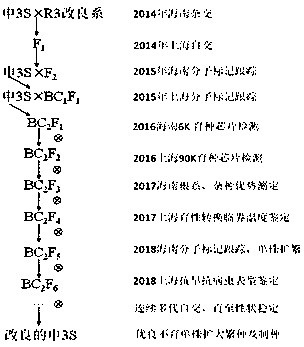Backcross breeding method for improving resistance of two-line sterile line to drought, rice blast and rice planthopper
A technology of backcross breeding and rice blast, applied in the direction of botany equipment and methods, application, plant gene improvement, etc., can solve the problems of non-resistance to rice blast, resistance to diseases and insect pests, no major improvement in drought lodging resistance, and decline in promotion area And other issues
- Summary
- Abstract
- Description
- Claims
- Application Information
AI Technical Summary
Problems solved by technology
Method used
Image
Examples
Embodiment
[0024] This implementation relates to a backcross breeding method for improving the resistance of two-line sterile lines to drought, rice blast and rice planthopper.
[0025] according to figure 1 Shown, the present invention comprises the following steps:
[0026] (1) The existing two-line CMS line Shen 3S was used as the female parent, and the drought-resistant and disease-resistant improved line Hanhui No. 3 was used as the male parent to obtain the F1 generation; the self-crossed generation obtained the F2 generation seeds.
[0027] (2) F2 was planted, and the resistant sterile plants (36 strains) in the F2 segregation generation of the improved line Hanhui 3 crossed with Shen 3S by molecular marker selection (MAS, marker-assisted selection) were the female parent and Shen 3S ( Fertile by cold irrigation) was improved by backcrossing, and BC1F1 seeds were obtained. In 2015, Shanghai continued to cross back with Shen 3S and obtained BC2F1 seed.
[0028] Screening of Pi9 ...
PUM
 Login to View More
Login to View More Abstract
Description
Claims
Application Information
 Login to View More
Login to View More - R&D
- Intellectual Property
- Life Sciences
- Materials
- Tech Scout
- Unparalleled Data Quality
- Higher Quality Content
- 60% Fewer Hallucinations
Browse by: Latest US Patents, China's latest patents, Technical Efficacy Thesaurus, Application Domain, Technology Topic, Popular Technical Reports.
© 2025 PatSnap. All rights reserved.Legal|Privacy policy|Modern Slavery Act Transparency Statement|Sitemap|About US| Contact US: help@patsnap.com



